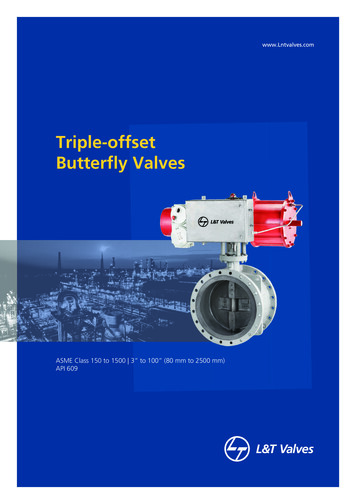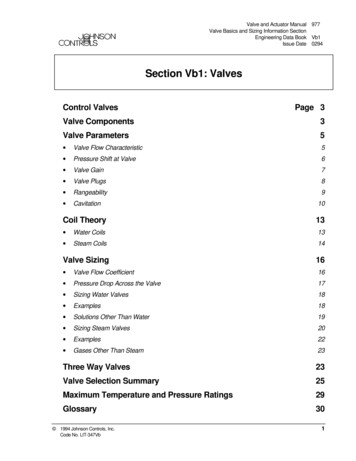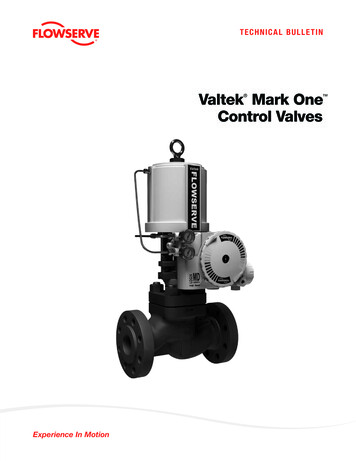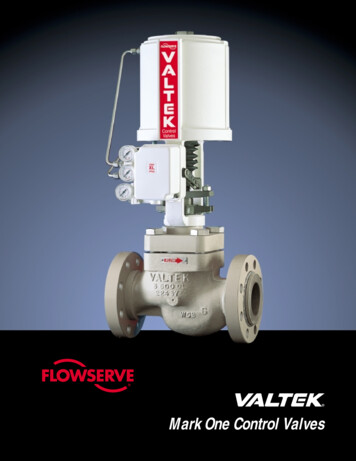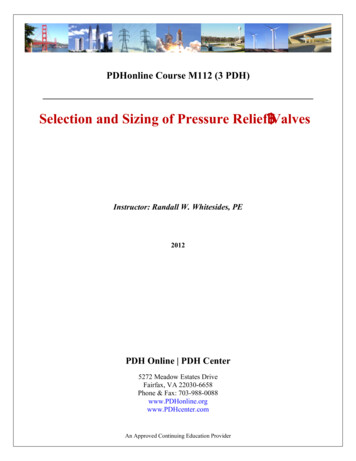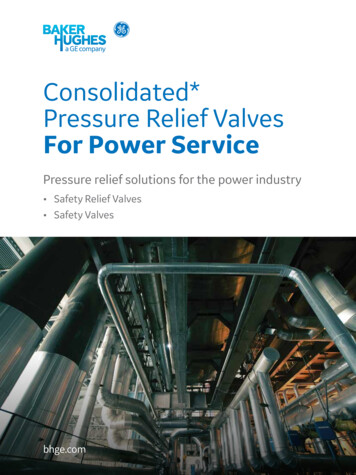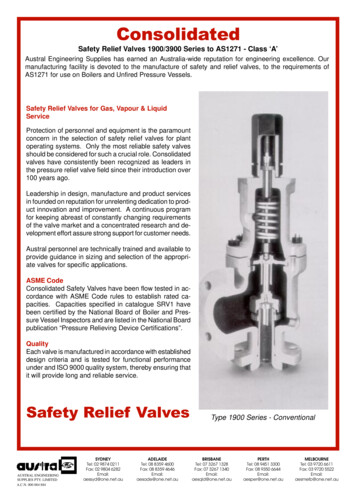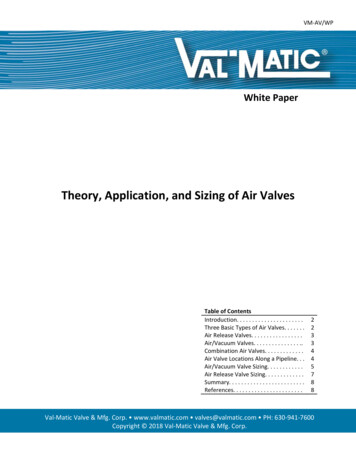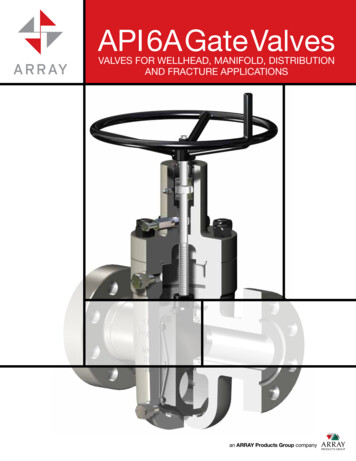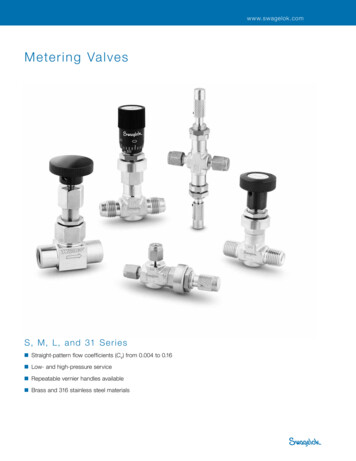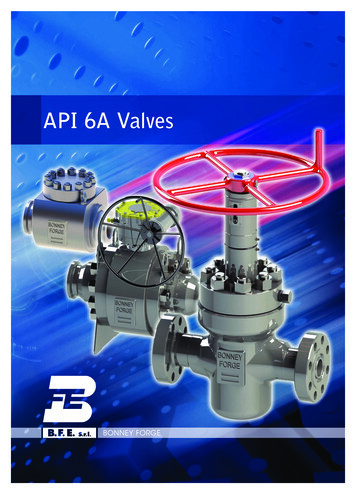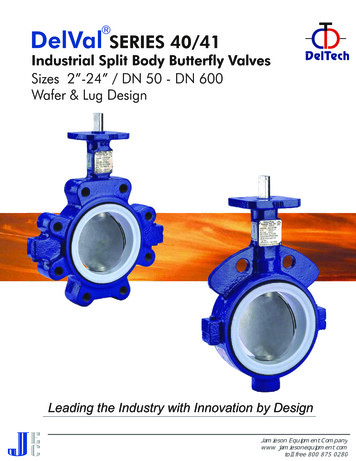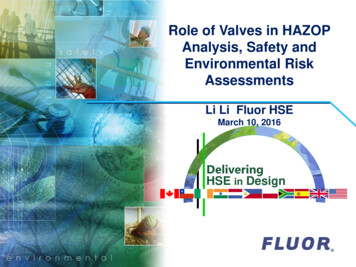
Transcription
Role of Valves in HAZOPAnalysis, Safety andEnvironmental RiskAssessmentsLi Li Fluor HSEMarch 10, 2016DeliveringHSE in Design
Topics1. HAZOP MethodologyWhat is HAZOP?Why to conduct HAZOP during EPC?When to do it?Who is responsible and who to participate HAZOP?Where to host the HAZOP meeting?How the HAZOP is conducted?After the HAZOP study2. Role of Valves in HAZOP Analysis3. Role of Valves in Human Factors Engineering4. Role of Valves in Safety and Environmental Risk Assessments5. Summary6. Take Away7. Further Studies8. Questions and Answers1)2)3)4)5)6)7)DeliveringHSE in Design
Acronym and ont End Engineering DesignHazard and Operability StudyHealth Safety and EnvironmentLayers Of Protection AnalysisOccupational Safety and Health AdministrationProcess Hazard AnalysisPiping and Instrumentation DiagramProcess Safety ManagementDefinitionsCatastrophic A major uncontrolled emission, fire, or explosion,Releaseinvolving one or more highly hazardous chemicals thatpresents serious danger to employees in the workplace.Risk:Measure of potential human injury, environmentaldamage, or economic loss in terms of both eventlikelihood and consequence severity.(Risk Likelihood x Consequence Severity)DeliveringHSE in Design
1. What is HAZOP?– One of the Many Process Hazard Analysis (PHA) Methodologies1.A systematic hazard identification methodology to identifyhazardous events that could occur during operation of thefacility caused by deviations from design intent.2.The potential causes and consequences are identified, and ajudgment is made as to whether additional design featuresshould be incorporated to safeguard against the identifiedscenarios.3.HAZOP serves as the final safety review in engineeringdesign phase prior to the Pre-Startup Safety Review (PSSR)4.Qualitative analysis5.The focus is on operating facilities involving hazardouschemicals, such as using, storing, refining, petrochemicals,manufacturing, moving, handling, etc. A lot discussions on valves!DeliveringHSE in Design
Why to Conduct HAZOP in EPC? United States federal government regulationsrequirement: US OSHA 29 CFR1910.119: Process Safety Management (PSM)of Highly Hazardous Chemicals, excerpt:(e) Process Hazard Analysis (PHA):(1) The employer SHALL perform an initial process hazard analysis(hazard evaluation) on processes covered by this standard. (2) The employer SHALL use one or more of following methodologies(next slide) to determine and evaluate the hazards of the processbeing analyzed. (3) to (7) . To identify and evaluate potential hazards and risks insafety, health and environmentTo identify corrective measures that will improve safetyDeliveringHSE in Design
When to Conduct HAZOP in EPC?Front EndHAZIDWhat-IfDetail EngineeringHAZOP, other methodologies:What-IfWhat-If ChecklistFMEA Failure Modes andEffects AnalysisFTA Fault Tree AnalysisETA Event Tree AnalysisCause- Consequence & Bow-TiePre-StartupPSSRNormally after the detail designis completed, 30-40% ofEngineering completion, P&IDsneed to be issued for design.IFDIFHIFCresolveHAZOP findings/recommendationsper Risk RankingDeliveringHSE in Design
Who is Responsible? andWho to Participate in HAZOP?1. Facility owner is responsible to perform & manage HAZOP.2. US OSHA 29 CFR 1910.119: Process Safety Management(PSM) of Highly Hazardous Chemicals, excerpt:– (e) Process Hazard Analysis (PHA): (4) The PHA SHALL be performed by a TEAM with expertise inengineering and operation 2.1 Required Core Members:Independent Facilitator: methodology,Scribe: technical recorderOperator: experience and knowledge of the facilityProcess Engineer: process design, including vendorsControl/Instrumentation/Electrical Engineer: instrumentdesign, including vendors2.2 Others: HSE, Mechanical, Maintenance, Piping, etc.DeliveringHSE in Design
Where the HAZOP is Conducted?Facility’s owner decision– Can be at the Site– Or at the EPC office locationsDeliveringHSE in Design
How the HAZOP is Conducted?In a group setting, with facilitated team discussions, a team ofdesign engineers and operators will evaluate the design andidentify:1. what could go wrong? the potential causes?2. initiating events, any previous incidents, etc.3. what are the resulted consequences in safety & environment?Risk ranking?4. what safe guards are already in place, what safe guards must tobe implemented to prevent the incidence, etc. (implement Layersof Protection Analysis (LOPA))5. Systematic and structured review on selected operation orsystem (node), on Potential Process Parameter Deviations byusing Guidewords. HAZOP Work sheets6. HAZOP Report7. Software: PHA Pro, PHA WorksDeliveringHSE in Design
How the HAZOP is Conducted? - cont.- Potential Process Parameter Deviations, GuidewordsExamples ofProcess Parameter Deviationsand Flow (Flow Control Valves) Pressure (Pressure Control Valves) Temperature Level Viscosity Impurity Change in composition Change in concentration Reactions Start-up, Shut down Maintenance, Service Human FactorsGuidewords:No, Less, More, MisdirectedHigh, Low, VacuumHigh, LowHigh, Low, ZeroHigh, LowMore, Less, UnexpectedMore of, Less ofMore of, Less ofMore of, Less ofDeliveringHSE in Design
2. Role of Valves in HAZOP - IMPORTANTValves are discussed a lot in HAZOP, Examples Under “Initiating Causes”: FCV-xxx Fails open when require to be closed FCV-xxx Fails close when require to be open PCV-xxx inadvertently close PCV-xxx inadvertently open Manual Valves inadvertently left open (e.g. after maintenance) Manual Valves inadvertently left close (e.g. after maintenance) Under “Safe Guards”: Pressure Relief Valves (PSV) Blowdown Valves Emergency Shutdown Valves Check valvesDeliveringHSE in Design
Supplemental Questions related with valves maybe asked“Guidelines for Hazard Evaluation Procedures”, 3rd Edition, excerpt:1. Can bypass valves (for control valves or other components)by quickly opened by operators? What hazards may result if the bypass is opened (e.g.reverse flow, high, or low level?) What by pass valves are routinely opened to increase flow,and will properly sized control valves be installed?2. How are the positions of critical valves (block valves beneathrelief devices, equipment isolation valves, dike drain valve,etc.) controlled? (car seals, locks, periodic checks, etc.)?3. Are critical isolation valve actuator powerful enough to closethe valves under worst case differential pressure conditions(including backflow) in the event of rupture?4. Are chain-operators for valves adequately supported andsized to minimize the likelihood of valve stem breakage?DeliveringHSE in Design
Supplemental Questions related with valves maybe asked“Guidelines for Hazard Evaluation Procedures”, 3rd Edition, excerpt:- cont. for info5. How are the positions of critical valves (e.g. emergencyisolation valves, dump valves) indicated to operators? Is theposition of all nonrising stem valves readily apparent to theoperators? Do control room display directly indicate thevalve position, or do they really indicate some otherparameter, such as actuator position or torque, application ofpower to the actuator, or initiation of a control signal to theactuator?6. Are block valves or double block and bleed valve required: because of high process temperature? because of high process pressure? because the process material is likely to erode or damagevalve internals? because the process material is likely to collect on thevalve seat? for worker protection during maintenance?DeliveringHSE in Design
Supplemental Questions related with valves maybe asked“Guidelines for Hazard Evaluation Procedures”, 3rd Edition, excerpt:- cont. for info7. How will control valves react to loss of control medium orsignal? Do the control valves: Reduce heat input (cut firing, reboiling, etc.)? Increase heat removal (increase reflux, quench, coolingwater flow, etc.)? Reduce pressure (open vents, reduce speed of turbines,etc.)? Maintain or increase furnace tube flow? Ensure adequate flow at compressors or pumps? Reduce or stop input of reactants? Reduce or stop makeup to recirculation system? Isolate the unit? Avoid overpressuring of upstream or downstreamequipment (e.g. by maintaining level to avoid gas blowby)? Avoid overcooling (below minimumdesired temperature)?DeliveringHSE in Design
Supplemental Questions related with valves maybe asked“Guidelines for Hazard Evaluation Procedures”, 3rd Edition, excerpt:- cont. for info8. Will control valves malfunction result in exceeding the designlimits of equipment or piping: Are upstream vessels between a pressure source and thecontrol valve designed for the maximum pressure when thecontrol valve close? Some piping’s class decreases after the control valves. Isthis piping suitable if the control valve is open and thedownstream block valve close? Is other equipment in thesame circuit? Is there any equipment whose material selection makes itsubject to rapid deterioration or failure if any specificmisoperation or failure of the control valve occurs(overheating, over cooling, rapid corrosion, etc.)? Will the reactor temperature run away? Is the three-way valve used in the pressure-relieving paththe equivalent of a fully open portin all valve positions?DeliveringHSE in Design
Supplemental Questions related with valves maybe asked“Guidelines for Hazard Evaluation Procedures”, 3rd Edition, excerpt:- cont. for info9. Is there provision in the design for a single control valve to fail: in the worst possible position (usually opposite the fail-safeposition)? With the bypass valve open?10. Upon a plant-wide or unit-wide loss of control medium or signal,which valves should fail to a position that is different from theirnormal failure position? How were the conflict resolved?11. Can the safety function of each automatically controlled valvebe tested while the unit is operating? Will an alarm sound if thesensing-signal-control loop fails or is deactivated? Should anybypass valves be car-sealed or locked closed?12. Are battery limit block valves easily accessible in anemergency?13. Are controllers and control valves readily accessible formaintenance?DeliveringHSE in Design
After the HAZOP Review Meeting HAZOP and LOPA ReportsResolution of the identified findings/recommendations, asrequired by US OSHA 29 CFR 1910.119 Process SafetyManagement (PSM), (e) PHA, (5)Need to resolve all findings/recommendations prior to P&IDsto be Issued for Construction (IFC).IFD IFHIFCresolveHAZOP findings/recommendations(prioritize per Risk Ranking)Compliance audits per US OSHA 29CFR1910.119 PSM, (o)DeliveringHSE in Design
3. Role of Valves in Human Factors Engineering- Valve Criticality as information Please understand the valve placement, orientation andlocation is owners’ responsibility. Same requirements for vendor skidsASTM F1166 – 07 “Standard Practice for Human EngineeringDesign for Marine Systems, Equipments, and Facilities” Provides ergonomic design criteria from a human-machineperspective for the design and construction of maritimevessels and structures and for equipment, systems, andsubsystems contained therein, including vendor-purchasedhardware and software. Section 12 “Valve Placement, Orientation and Location”provided Valve Criticality information for variety valves, thisinformation helps to recognize the importance and criticalityof valves.DeliveringHSE in Design
3. Role of Valves in Human Factors Engineering- Valve Criticality as informationCategory 1 – Critical and essential for normal or emergency operations,safety and environmental Used frequently (at least once in a six month period) Have a high likelihood of failure, the consequence of failure orlack of quick access would be serious, Valve with handwheels or handles greater than 610 mm (24 in.)in diameter or length. Examples: Control valves, their bypass, isolation valves Relief and depressuring valves, emergency shut down Trip and anti-surge valves Liquid cargo transfer valves (HC)DeliveringHSE in Design
3. Role of Valves in Human Factors Engineering- Valve Criticality as informationCategory 2 – NOT critical for normal operations but required forroutine operations and maintenance Used frequently (at least once in a six month period) Examples: Sewage treatment valves Condensate drain valves Service oil valves Potable water valves Ship service air valves Hydraulic service Defrost gas valve Manual valves for normal startup /shutdown Drains and vents (1 in.) or less with flange and cap end.DeliveringHSE in Design
3. Role of Valves in Human Factors Engineering- Valve Criticality as informationCategory 3 – Normally Non- operating valves that are used inparticular circumstances on an infrequent basis Examples: Valves used in drydock only For initial vessel or structure commissioning For Decommissioning Only during start-ups after extended shutdowns During extended shutdowns To isolate pressure vessels, tanks, etc. for inspections Tie-in valves For pressure testDeliveringHSE in Design
4. Role of Valves in Safety & EnvironmentalRisk Assessments Emphasized on isolation and emergency valvesIn quantitative risk analysis, the resulted consequence isnormally calculated and based on inventory, chemical andphysical properties of the released hazardous material. To reduce leaking inventories Fire Hazard Analysis per API RP 2218 FireproofingIf the emergency valves (including actuators) arewithin Fire Scenario Envelope (exposed to fire) Fireproof power and signal lines, motor operator perSec.5.1.9 DeliveringHSE in Design
5. Summary HAZOP Methodologya. HAZOP is one of the many Process Hazards Analysis(PHA) methodologiesb. PHA is required by US OSHA 29 CFR 1910.119: ProcessSafety Management (PSM) of Highly Hazardous Chemicalsc. Owners responsibilityd. Qualitative analysis, wide used in EPCe. Facilitated group discussion using
US OSHA 29 CFR1910.119: Process Safety Management (PSM) of Highly Hazardous Chemicals, excerpt: . required by US OSHA 29 CFR 1910.119 Process Safety Management (PSM), (e) PHA, (5) Need to resolve all findings/recommendations prior to P&IDs to be Issued for Construction (IFC). IFD IFH IFC resolve HAZOP findings/ recommendations (prioritize per Risk Ranking) Compliance audits per US OSHA .
